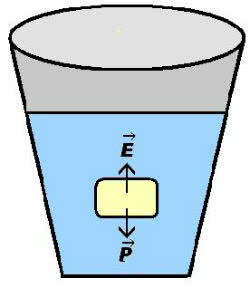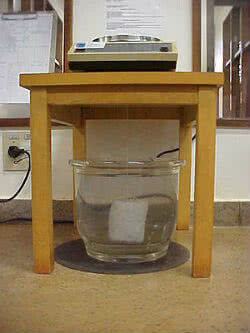Hydrostatics is an area of physics that studies the liquids that are at rest. This branch involves several concepts such as density, pressure, volume and buoyant force.
Main Concepts of Hydrostatics
Density
Density determines the concentration of matter in a given volume.
Regarding the density of the body and fluid we have:
- If the density of the body is less than the density of the fluid, the body will float on the surface of the fluid;
- If the density of the body is equal to the density of the fluid, the body will be in equilibrium with the fluid;
- If the density of the body is greater than the density of the fluid, the body will sink.
To calculate the density, the following formula is used:
d = m/v
being,
d: density
m: pasta
v: volume
In the international system (SI):
- density is in grams per cubic centimeter (g/cm3), but it can also be expressed in kilograms per cubic meter (kg/m3) or in grams per milliliter (g/ml);
- the mass is in kilograms (Kg);
- the volume is in cubic meters (m3).
Also read about the Density and the water density.
Pressure
Pressure is an essential concept of hydrostatics, and in this area of study it is called hydrostatic pressure. It determines the pressure that fluids exert on others.
As an example, we can think of the pressure we feel when we are swimming. So the deeper we dive, the greater the hydrostatic pressure.
This concept is closely related to fluid density and gravity acceleration. Therefore, the hydrostatic pressure is calculated using the following formula:
P = d. H. g
Where,
P: hydrostatic pressure
d: liquid density
H: height of liquid in container
g: gravity acceleration
In the International System (SI):
- the hydrostatic pressure is in Pascal (Pa), but the atmosphere (atm) and the millimeter of mercury (mmHg) are also used;
- the density of the liquid is in grams per cubic centimeter (g/cm3);
- height is in meters (m);
- the acceleration of gravity is in meters per second squared (m/sec2).
Note: Note that the hydrostatic pressure does not depend on the shape of the container. It depends on the density of the fluid, the height of the column of the liquid and the gravity of the location.
Want to know more? Also read about the Atmospheric pressure.
Buoyancy
The thrust, also called the thrust, is a hydrostatic force that acts on a body that is immersed in a fluid. Thus, the buoyant force is the resultant force exerted by the fluid on a given body.
As an example, we can think of our body that feels lighter when we are in the water, whether in the pool or the sea.
Note that this force exerted by the liquid on the body was already studied in antiquity.
The Greek mathematician Archimedes was the one who carried out a hydrostatic experiment that allowed him to calculate the value of the buoyant force (vertical and upward) that makes a body lighter inside a fluid. Note that it acts in the opposite direction to strength weight.
 Actuation of the buoyant force and weight force
Actuation of the buoyant force and weight force
Thus, the statement of the Archimedes' Theorem or Law of Buoyancy is:
“Every body immersed in a fluid receives a bottom-up impulse equal to the weight of the volume of the fluid displaced, therefore, the bodies denser than water sink, while the less dense float”.
Regarding the buoyant force, we can conclude that:
- If the buoyant force (E) is greater than the weight force (P), the body will rise to the surface;
- If the buoyant force (E) has the same intensity as the weight force (P), the body will neither rise nor fall, remaining in balance;
- If the buoyant force (E) is less than the weight force (P), the body will sink.

Remember that the buoyant force is a Vector greatness, that is, it has direction, module and meaning.
In the International System (SI), the thrust (E) is given in Newton (N) and calculated by the following formula:
E = df. Vfd. g
Where,
AND: buoyant force
df: fluid density
Vfd: fluid volume
g: gravity acceleration
In the International System (SI):
- the fluid density is in kilograms per cubic meter (kg/m3);
- the fluid volume is in cubic meters (m3);
- the acceleration of gravity is in meters per second squared (m/sec2).
Read the thrust formula.
Hydrostatic Scale
The hydrostatic balance was invented by the Italian physicist, mathematician and philosopher Galileo Galilei (1564-1642).
Based on Archimedes' Principle, this instrument serves to measure the buoyant force exerted on a body immersed in a fluid.
That is, it determines the weight of an object immersed in a liquid, which in turn is lighter than in air.
 Hydrostatic Scale
Hydrostatic Scale
Read too: Pascal's Principle.
Fundamental Law of Hydrostatics
O Stevin's Theorem is known as the “Fundamental Law of Hydrostatics”. This theory postulates the relation of variation between the volumes of liquids and the hydrostatic pressure. Its statement is expressed as follows:
“The difference between the pressures of two points of a fluid at equilibrium (resting) is equal to the product between the density of the fluid, the acceleration of gravity and the difference between the depths of the points.”
Stevin's Theorem is represented by the following formula:
∆P = γ ⋅ oh or ∆P = d. g. oh
Where,
∆P: hydrostatic pressure variation
γ: specific weight of the fluid
oh: liquid column height variation
d: density
g: gravity acceleration
In the International System (SI):
- the variation of hydrostatic pressure is in Pascal (Pa);
- the specific weight of the fluid is in Newton per cubic meters (N/m3);
- the variation in the height of the column of liquid is in meters (m);
- density is in kilograms per cubic meters (kg/m3);
- the acceleration of gravity is in meters per second squared (m/sec2).
Hydrostatics and Hydrodynamics
While hydrostatics study liquids at rest, hydrodynamics is the branch of physics that studies the movement of these fluids.
Entrance Exam Exercises with Feedback
1. (PUC-PR) Buoyancy is a very familiar phenomenon. One example is the relative ease with which you can get up from inside a pool compared to trying to get up from out of the water, ie in the air.
According to Archimedes' principle, which defines thrust, mark the correct proposition:
a) When a body floats on water, the buoyancy received by the body is less than the body's weight.
b) Archimedes' principle is only valid for bodies immersed in liquids and cannot be applied to gases.
c) A body fully or partially immersed in a fluid experiences an upward vertical force equal in module to the weight of the displaced fluid.
d) If a body sinks in water with constant velocity, the buoyancy on it is nil.
e) Two objects of the same volume, when immersed in liquids of different densities, suffer equal thrust.
Alternative c
2. (UERJ-RJ) A raft, whose shape is a rectangular parallelepiped, floats on a freshwater lake. The base of its hull, whose dimensions are equal to 20 m in length and 5 m in width, is parallel to the free surface of the water and submerged at a distance from that surface. Assume that the raft is loaded with 10 automobiles, each weighing 1,200 kg, so that the base of the hull remains parallel to the free surface of the water, but submerged at a distance d from that surface.
If the density of water is 1.0 × 103 kg/m3, the variation (d – do), in centimeters, is: (g=10m/s2)
a) 2
b) 6
c) 12
d) 24
e) 22
Alternative c
3. (UNIFOR-CE) Two liquids, A and B, chemically inert, and not miscible with each other, with densities dA=2.80g/cm3 and dB=1.60g/cm3, respectively, are placed in the same container. Knowing that the volume of liquid A is twice that of B, the density of the mixture, in g/cm3, OK:
a) 2.40
b) 2.30
c) 2.20
d) 2.10
e) 2.00
Alternative to
For more questions, with commented resolution, see also: Hydrostatic Exercises.



